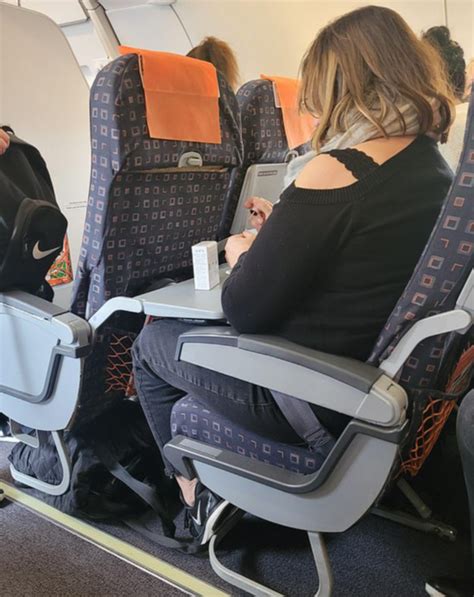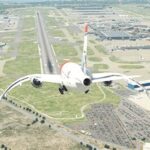
A travel influencer is facing fierce backlash online after sharing a “comfy” flight hack involving creating a makeshift bed across multiple airplane seats, prompting accusations of inconsiderate behavior and disregard for fellow passengers.
Natalie, known as @nataliewysocka on TikTok, ignited controversy after posting a video demonstrating how she strategically used an inflatable cushion to transform a row of seats into a personal sleeping area during a recent flight. While Natalie presented the hack as a way to achieve comfort and rest during travel, the video sparked immediate outrage, with many viewers criticizing the move as selfish and potentially disruptive to other passengers. Critics argued that the “hack” infringes on the personal space of others, especially those who may have paid for specific seat assignments or require access to the aisle. The online uproar underscores a growing debate about etiquette and personal responsibility in shared travel spaces.
The now-viral TikTok video showcased Natalie inflating a sizable cushion designed to bridge the gap between airplane seats. Text overlaid on the video read, “The flight isn’t comfy unless…” followed by footage of her relaxing on the makeshift bed. The video quickly accumulated millions of views, but the comments section became a battleground, with users expressing both support and vehement opposition to the influencer’s actions.
“This is incredibly inconsiderate to other passengers,” one commenter wrote, reflecting the general sentiment of many critics. Others questioned the legality and safety of using such devices on airplanes, citing potential obstructions to emergency exits and the comfort of other travelers.
Defenders of Natalie argued that if the seats were unoccupied, she was not harming anyone and was simply maximizing her comfort within the available space. Some pointed out that airlines often allow passengers to spread out if a flight is not fully booked. However, the overwhelming response was negative, with many accusing Natalie of prioritizing her comfort above the well-being and convenience of others.
This incident highlights a growing tension between individual comfort and shared space etiquette in the context of air travel. As airlines continue to reduce seat sizes and increase passenger density, travelers are increasingly seeking ways to enhance their comfort. However, the pursuit of personal comfort can often come at the expense of others, leading to conflicts and debates about what constitutes acceptable behavior in the confined environment of an airplane cabin. The debate also extends to airline policies and the responsibilities of flight attendants in managing passenger behavior and ensuring a comfortable and safe flight for everyone.
The controversy surrounding Natalie’s “comfy” flight hack serves as a reminder of the importance of considering the impact of one’s actions on others, particularly in shared spaces like airplanes. While personal comfort is undoubtedly a priority for many travelers, it should not come at the cost of infringing on the rights and comfort of fellow passengers.
The influencer, Natalie, has yet to respond directly to the criticism as of the time of this rewrite. The original video remains accessible on her TikTok account, continuing to fuel the ongoing debate.
Expanding on the Controversy and Ethical Considerations:
The core of the controversy lies in the perceived selfishness of the act. While some argue that utilizing empty seats is harmless if no one is inconvenienced, the reality of air travel often involves a more complex interplay of factors.
-
Space and Entitlement: One of the central arguments against Natalie’s actions is the notion of entitlement to space. Each passenger pays for a specific seat, and the assumption is that the space associated with that seat is theirs for the duration of the flight. Creating a makeshift bed across multiple seats effectively appropriates space that could potentially be used by other passengers, even if those seats appear unoccupied at the moment. Flights can fill up unexpectedly, and even if the flight seems empty initially, the possibility of last-minute bookings or stand-by passengers remains. Moreover, even if seats remain unoccupied, some passengers may have preferred those seats for their legroom or proximity to the aisle or window.
-
Accessibility and Mobility: Another significant concern is accessibility. A makeshift bed can obstruct the aisle, making it difficult for other passengers to move around, especially during meal service, bathroom breaks, or in the event of an emergency. Passengers with mobility issues, such as those using wheelchairs or crutches, may find it particularly challenging to navigate a cabin with obstructed aisles. Flight attendants also need clear access to the aisles to perform their duties, including safety checks and assisting passengers.
-
Visual Impact and Perceived Fairness: Even if the makeshift bed doesn’t directly impede anyone’s movement or take up space someone else would otherwise use, it can still create a sense of unfairness. Passengers who are cramped in their assigned seats may feel resentment towards someone who appears to be flaunting their ability to create a more comfortable experience. This can lead to a sense of injustice and contribute to a negative atmosphere on the flight. The visual of someone seemingly privileged and able to “game the system” can be particularly grating for those who are struggling with the discomforts of air travel.
-
Airline Regulations and Enforcement: The legality of using inflatable cushions or other devices to create makeshift beds on airplanes is often ambiguous and depends on the specific airline’s policies. Some airlines explicitly prohibit such devices, citing safety concerns or potential disruptions to other passengers. However, enforcement of these policies can be inconsistent. Flight attendants may be reluctant to confront passengers, especially if the flight is not full and the device doesn’t appear to be causing any immediate problems. This inconsistency in enforcement can further fuel the perception of unfairness.
-
The “Slippery Slope” Argument: Critics also raise the “slippery slope” argument, suggesting that if such behavior is tolerated, it could lead to more passengers attempting to create makeshift beds, potentially exacerbating the problems of space and accessibility. If everyone tried to create a personal sleeping area, the cabin would become chaotic and difficult to navigate. This argument highlights the importance of setting clear boundaries and enforcing rules to maintain order and ensure a comfortable and safe environment for all passengers.
-
The Role of Influencers and Social Media: The fact that Natalie is a travel influencer adds another layer to the controversy. Influencers have a responsibility to promote ethical and responsible behavior, especially when showcasing their travel experiences to a large audience. By promoting a “hack” that is perceived as selfish and inconsiderate, Natalie has potentially encouraged others to engage in similar behavior, without fully considering the potential consequences. This highlights the ethical considerations that influencers must take into account when sharing content that could impact others.
-
Airline Design and Passenger Experience: The controversy also shines a light on the broader issue of airline design and passenger experience. As airlines seek to maximize profits, they often prioritize cramming more seats into the cabin, resulting in less legroom and overall discomfort for passengers. This creates a demand for “hacks” and devices that can improve comfort, but it also exacerbates the tensions surrounding space and etiquette. Addressing the root cause of the problem, by improving seat design and spacing, could help to alleviate some of the pressure and reduce the likelihood of conflicts between passengers.
Exploring the Broader Context of Air Travel Etiquette:
The incident involving Natalie’s flight hack is just one example of the many challenges and debates surrounding air travel etiquette. The confined space of an airplane cabin, combined with the stresses of travel, can often lead to conflicts between passengers.
-
Reclining Seats: One of the most common sources of conflict is reclining seats. While airlines generally allow passengers to recline their seats, doing so can significantly reduce the legroom of the passenger behind, leading to discomfort and resentment. Some passengers argue that reclining seats is a right, while others believe it is inconsiderate and should be limited or prohibited.
-
Armrest Etiquette: The battle for the armrest is another frequent source of tension. In a typical row of seats, there are only two armrests for three passengers, leading to competition for the limited space. Etiquette dictates that the middle seat passenger should have both armrests as compensation for their less desirable seating position, but this is not always followed, leading to disputes.
-
Noise Levels: Noise levels can also be a source of conflict on airplanes. Passengers who talk loudly, play music without headphones, or allow their children to make excessive noise can disrupt the peace and quiet of the cabin. While some noise is inevitable, excessive noise can be particularly bothersome on long flights, when passengers are trying to rest or work.
-
Personal Hygiene: Personal hygiene is another important aspect of air travel etiquette. Passengers who have strong body odor or engage in behaviors that are considered unhygienic can create discomfort for those around them. While it can be difficult to address these issues directly, it is important to be mindful of one’s own hygiene and its potential impact on others.
-
Overhead Bin Space: Competition for overhead bin space is another common source of stress. As airlines increasingly charge for checked baggage, more passengers are carrying on luggage, leading to crowded overhead bins. Passengers who take up excessive space with oversized bags or who fill the bins with unnecessary items can prevent others from storing their luggage.
-
Dealing with Disruptive Passengers: Flight attendants are often called upon to mediate disputes between passengers and deal with disruptive behavior. This can range from addressing noise complaints to resolving conflicts over reclining seats or armrest etiquette. Flight attendants have the authority to take action against passengers who violate airline regulations or create a disturbance, but they often prefer to resolve issues peacefully and avoid escalating conflicts.
Analyzing the Legal and Regulatory Aspects:
While the primary focus of the controversy surrounding Natalie’s flight hack is on etiquette and ethical considerations, there are also legal and regulatory aspects to consider.
-
Airline Policies and Contracts of Carriage: Airlines have specific policies and contracts of carriage that govern passenger behavior and the use of equipment on board. These policies often prohibit actions that could endanger the safety of the flight or disrupt other passengers. Using inflatable cushions or other devices to create makeshift beds could potentially violate these policies, depending on the specific wording and the airline’s interpretation.
-
Federal Aviation Regulations (FARs): The Federal Aviation Administration (FAA) also has regulations that address passenger safety and conduct on airplanes. These regulations prohibit passengers from interfering with the duties of the flight crew, obstructing emergency exits, or engaging in other behaviors that could jeopardize the safety of the flight. Using a makeshift bed that obstructs the aisle or interferes with emergency procedures could potentially violate these regulations.
-
Flight Attendant Authority: Flight attendants have the authority to enforce airline policies and FAA regulations on board the aircraft. They can instruct passengers to cease disruptive behavior, confiscate prohibited items, and even request law enforcement assistance if necessary. Passengers who refuse to comply with flight attendant instructions can face penalties, including fines, removal from the flight, and even criminal charges.
-
Liability and Insurance: In the event that a passenger is injured as a result of another passenger’s actions, the issue of liability and insurance may arise. For example, if a passenger trips over a makeshift bed in the aisle and sustains an injury, the person who created the bed could potentially be held liable for the damages. Airlines also have insurance policies that cover injuries to passengers, but these policies may have limitations or exclusions that could apply in certain situations.
-
Enforcement Challenges: Enforcing airline policies and FAA regulations can be challenging for flight attendants, especially on crowded flights. They must balance the need to maintain order and safety with the desire to avoid confrontations and minimize disruptions. In some cases, flight attendants may choose to overlook minor violations, rather than risk escalating a situation. However, this can lead to inconsistencies in enforcement and contribute to a perception of unfairness.
The Future of Air Travel Etiquette and Design:
The controversy surrounding Natalie’s flight hack highlights the need for a broader conversation about air travel etiquette and design. As air travel becomes increasingly crowded and stressful, it is important to find ways to balance the needs of individual passengers with the overall well-being of the community.
-
Rethinking Seat Design and Spacing: Airlines could consider rethinking seat design and spacing to provide more legroom and overall comfort for passengers. This could involve increasing the pitch between rows of seats, redesigning seats to be more ergonomic, or offering premium seating options with more space and amenities.
-
Clearer Communication of Etiquette Guidelines: Airlines could also do a better job of communicating etiquette guidelines to passengers. This could involve providing information about reclining seats, armrest etiquette, noise levels, and other common sources of conflict. This information could be included in pre-flight announcements, in-flight magazines, or on the airline’s website.
-
Technology and Innovation: Technology could also play a role in improving the air travel experience. For example, airlines could use sensors to monitor noise levels in the cabin and alert flight attendants to potential disruptions. They could also develop apps that allow passengers to communicate with each other and resolve conflicts peacefully.
-
Promoting Empathy and Understanding: Ultimately, improving air travel etiquette requires a shift in mindset. Passengers need to be more empathetic and understanding of each other’s needs and perspectives. This involves recognizing that everyone is trying to make the best of a challenging situation and being willing to compromise and cooperate to create a more positive experience for all.
-
The Role of Airline Staff Training: Airlines should invest in better training for their staff, particularly flight attendants, to effectively manage passenger disputes and enforce etiquette policies. This training should cover de-escalation techniques, conflict resolution strategies, and a thorough understanding of airline rules and regulations.
-
Standardization of Rules: Greater standardization of rules across different airlines could help reduce confusion and improve consistency. Clear guidelines on the use of inflatable devices, reclining seats, and other common sources of contention would benefit both passengers and crew.
Frequently Asked Questions (FAQ):
1. What exactly did the influencer do that caused the controversy?
Natalie, a travel influencer known as @nataliewysocka on TikTok, posted a video showing her using an inflatable cushion to create a makeshift bed across multiple airplane seats. This was presented as a “comfy” flight hack, but it sparked outrage online due to concerns about inconsiderate behavior and potential disruption to other passengers.
2. Why are people criticizing the influencer’s flight hack?
Critics argue that the “hack” is selfish and infringes on the personal space of other passengers. Concerns include the potential obstruction of aisles, limiting accessibility for others (especially those with mobility issues), and creating a sense of unfairness for passengers cramped in their assigned seats. Additionally, there are questions about the legality and safety of using such devices on airplanes.
3. Are inflatable cushions or similar devices allowed on airplanes?
The legality of using inflatable cushions or other devices to create makeshift beds on airplanes depends on the specific airline’s policies. Some airlines explicitly prohibit such devices, citing safety concerns or potential disruptions to other passengers. It’s essential to check with the airline before using such items.
4. What do airline policies typically say about passenger conduct and the use of space?
Airline policies and contracts of carriage typically prohibit actions that could endanger the safety of the flight or disrupt other passengers. These policies often address issues like obstructing aisles, interfering with emergency procedures, and behaving in a manner that is offensive or disruptive to others.
5. What actions can flight attendants take if a passenger is being disruptive or violating airline policies?
Flight attendants have the authority to enforce airline policies and FAA regulations on board the aircraft. They can instruct passengers to cease disruptive behavior, confiscate prohibited items, and even request law enforcement assistance if necessary. Passengers who refuse to comply with flight attendant instructions can face penalties, including fines, removal from the flight, and even criminal charges.
In-depth Analysis of Social Media’s Role:
The controversy surrounding Natalie’s flight hack is significantly amplified by the power and reach of social media. Platforms like TikTok, Instagram, and Twitter serve as immediate conduits for sharing opinions, both positive and negative, and can quickly transform a relatively isolated incident into a global debate.
-
Viral Spread and Amplification: The nature of social media algorithms often prioritizes content that generates strong reactions, regardless of whether those reactions are positive or negative. This means that controversial content, like Natalie’s flight hack video, can quickly go viral, reaching millions of viewers in a short period. The comments section of these platforms then becomes a breeding ground for debate, with users passionately expressing their opinions and further amplifying the controversy.
-
The Power of Influencers: Influencers hold significant sway over their followers, and their actions can have a ripple effect. When an influencer promotes a particular product, service, or behavior, it can influence the choices and actions of their audience. In this case, Natalie’s promotion of a “comfy” flight hack, even if unintentional, could encourage others to engage in similar behavior, without fully considering the potential consequences.
-
Public Shaming and “Cancel Culture”: Social media can also be a tool for public shaming and “cancel culture,” where individuals are subjected to intense online criticism and ostracism for perceived wrongdoings. While some argue that this serves as a form of accountability, others criticize it as being excessive and disproportionate to the offense. Natalie’s case illustrates the potential for social media to amplify negative sentiment and subject individuals to intense scrutiny.
-
The Disconnect Between Online and Offline Behavior: It’s important to recognize that online opinions may not always reflect real-world behavior. While many people may express outrage about Natalie’s flight hack online, it’s possible that few would actually confront her directly on the plane. This disconnect highlights the potential for social media to create a distorted perception of public opinion.
-
The Importance of Context and Nuance: Social media often lacks the context and nuance necessary for a balanced understanding of complex issues. Comments are often short and reactive, without fully considering the complexities of the situation. This can lead to misunderstandings and misinterpretations, further fueling the controversy.
-
The Role of Social Media Companies: Social media companies have a responsibility to moderate content and prevent the spread of misinformation and hate speech. However, balancing this responsibility with the need to protect free speech can be a challenging task. In cases like Natalie’s, social media companies must decide whether to remove content that is deemed offensive or disruptive, while also respecting the right of users to express their opinions.
The Psychology of Entitlement and Shared Spaces:
Understanding the psychological factors that contribute to the controversy surrounding Natalie’s flight hack requires examining the concepts of entitlement and shared spaces.
-
The Psychology of Entitlement: Entitlement is the belief that one is inherently deserving of certain privileges or advantages, often without acknowledging the needs or rights of others. In the context of air travel, some passengers may feel entitled to more space, comfort, or preferential treatment, even if it comes at the expense of others. This sense of entitlement can stem from various factors, including socioeconomic status, frequent flyer status, or simply a belief that one is superior to others.
-
The Impact of Stress and Discomfort: Air travel can be a stressful and uncomfortable experience, with long lines, crowded airports, and cramped seating conditions. These stressors can exacerbate feelings of entitlement and make passengers more likely to prioritize their own needs over the needs of others. When people are feeling stressed and uncomfortable, they may be less likely to empathize with their fellow passengers and more likely to act in ways that are perceived as selfish.
-
The “Tragedy of the Commons”: The concept of the “tragedy of the commons” is relevant to understanding the challenges of shared spaces like airplanes. This concept describes a situation in which individuals acting independently and rationally according to their own self-interest deplete a shared resource, even when it is clear that it is not in anyone’s long-term interest. In the context of air travel, passengers may individually seek to maximize their comfort, even if it collectively diminishes the experience for everyone else.
-
The Role of Social Norms: Social norms play a crucial role in regulating behavior in shared spaces. These norms are unwritten rules or expectations about how people should behave in certain situations. In the case of air travel, social norms dictate that passengers should be respectful of others, avoid disruptive behavior, and share common resources fairly. However, when these norms are not clearly defined or consistently enforced, it can lead to conflict and a breakdown of social order.
-
The Importance of Empathy and Perspective-Taking: Overcoming the challenges of entitlement and shared spaces requires empathy and perspective-taking. Passengers need to be able to understand and appreciate the needs and perspectives of their fellow travelers, even when they differ from their own. This involves putting oneself in the shoes of others and considering how one’s actions might impact them.
Comparative Analysis with Similar Controversies:
Natalie’s “comfy” flight hack is not an isolated incident. There have been numerous similar controversies involving passenger behavior on airplanes, highlighting recurring themes and challenges.
-
“Manspreading”: The term “manspreading” refers to the practice of men sitting with their legs wide apart on public transportation, occupying more than one seat and infringing on the personal space of others. This practice has sparked considerable controversy, with critics arguing that it is a form of male privilege and a disregard for the comfort of female passengers.
-
Bare Feet on Armrests or Bulkheads: Passengers placing their bare feet on armrests or bulkheads is another common source of complaint. This behavior is considered unhygienic and disrespectful to other passengers, who are forced to share the contaminated space.
-
Loud Phone Conversations: Passengers engaging in loud phone conversations can be disruptive and annoying to others, especially on long flights. While some airlines now offer Wi-Fi, allowing passengers to communicate via text or email, others still permit phone calls, leading to conflicts over noise levels.
-
Bringing Emotional Support Animals: The increasing number of passengers bringing emotional support animals (ESAs) on airplanes has also sparked controversy. While ESAs can provide comfort and support to their owners, they can also be disruptive or even dangerous to other passengers, especially if they are not properly trained or controlled.
-
The “Knee Defender” Controversy: The “Knee Defender” is a device that prevents the passenger in front from reclining their seat. This device has sparked heated debates, with some arguing that it protects their legroom, while others argue that it infringes on the rights of the passenger in front.
-
The Leggings Incident (United Airlines): In 2017, United Airlines faced criticism after preventing two teenage girls from boarding a flight because they were wearing leggings. The airline argued that the girls were traveling on employee passes and were therefore subject to a dress code. However, the incident sparked outrage, with many accusing the airline of sexism and discrimination.
Analyzing these similar controversies reveals several common threads:
- Conflicts over Space and Comfort: Many of these controversies involve conflicts over space and comfort, highlighting the challenges of sharing limited resources in a confined environment.
- Issues of Respect and Consideration: Many of these controversies also involve issues of respect and consideration for others, underscoring the importance of etiquette and social norms.
- The Role of Airline Policies and Enforcement: Airline policies and enforcement practices play a crucial role in regulating passenger behavior and resolving conflicts.
- The Power of Social Media to Amplify Controversies: Social media has the power to amplify these controversies and subject individuals and airlines to intense scrutiny.
Conclusion:
The controversy surrounding Natalie’s “comfy” flight hack is more than just a fleeting internet outrage. It encapsulates a complex web of issues surrounding air travel etiquette, personal space, social responsibility, and the influence of social media. The incident serves as a microcosm of the broader challenges faced in increasingly crowded public spaces, where the pursuit of individual comfort can often clash with the need for consideration and respect for others. As air travel continues to evolve, it is crucial for airlines, passengers, and social media platforms to engage in a thoughtful dialogue about these issues, fostering a more harmonious and equitable travel experience for all. This requires not only clear guidelines and consistent enforcement but also a greater emphasis on empathy, understanding, and a recognition that shared spaces demand shared responsibility. By addressing these challenges head-on, we can work towards creating a more comfortable and respectful environment for everyone who takes to the skies.









